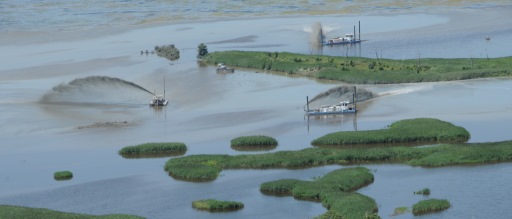For many years, folks driving Delaware‘s coastal Prime Hook Road suffered through frequent flooding. The culprit was an old, badly-designed bridge that didn’t allow tidal waters to flow properly in and out of the marshes of the Prime Hook National Wildlife Refuge.
That bridge has now been replaced, as part of a $38 million marsh restoration funded by the Department of the Interior, which was motivated by the devastation of Superstorm Sandy.
The project will restore a highly damaged tidal marsh/barrier beach ecosystem covering about 4,000 acres within the former freshwater impoundment system on the refuge. This coastal wetland restoration improves the ability of the refuge marshes to withstand future storms and sea level rise and improves habitat for migratory birds and other wildlife.
“By restoring this marsh we’ve been able to provide additional habitat for water fowl and again as well as preventing flooding and making our coastal communities more resilient,” says DNREC Deputy Secretary Kara Coats.
With this bridge replacement, the construction work on the refuge’s restoration project is essentially complete. The past 15 months have been a whirlwind of restoration activities along the refuge shoreline and within the marsh interior:
- A dune, beach, and back-barrier beach platform has been restored along nearly 8,000 feet of shoreline, including closure of four large breaches, using more than 1 million cubic yards of dredged from the Delaware Bay.
- The restored dune is 9 feet high with a 100- to 600-foot-wide back barrier platform extending into the marsh.
- American beach grass was planted and 10,000 feet of fencing have been installed to stabilize the dune and back barrier.
- Tidal marsh and dune grasses (Panicum and Spartina species) were planted in portions of the back barrier platform, to promote a return to vegetated salt marsh.
- More than 25 miles of tidal channels have been dredged out in the marsh interior to restore flow of tidal water throughout the wetland complex; The channel network was designed in large part based on historic tidal channels present prior to conversion of the wetlands to freshwater impoundments.
- Several man-made water-control structures were removed to improve tidal connection with the existing salt marshes to the north and south of the refuge.
- Restoration has reduced water levels in much of the marsh interior, especially in Unit III. Tidal wetland grasses and other vegetation have already begun to recolonize many of the exposed mud flat areas, although full recovery will take some time.
- Wild millet seed was scattered from the air over 1,000 acres in the Unit 3 impoundment, in order to give revegetation in that area a boost.
- Asphalt pieces of what was left the easternmost 1,800-foot section of Fowler Beach Road were removed; The refuge hopes to eventually construct a walkway to the beach.
- Most of the restored wetlands will revert back to a saltwater marsh with some areas of fresher or brackish wetlands.
The biological response to the restoration was immediate and impressive. Spring brought the horseshoe crabs to the brand new beach to spawn, in larger numbers than anticipated. The first documented piping plover nest was found on the restored shoreline, along with nesting by other birds of interest such as American oystercatchers and least terns. Many areas of the restored wetland were covered with new vegetation this year, where just last year there was shallow open water.
Monitoring of the biological response will continue over upcoming years. The refuge works closely with partners at the Delaware Department of Natural Resources and Environmental Control (DNREC) and the University of Delaware to monitor vegetation, birds, fish, and physical factors such as water quality and marsh elevation.
See full WDMT article and news video by Dani Bozzini.
See U.S. Fish & Wildlife Service page on Prime Hook restoration + photo credit.

